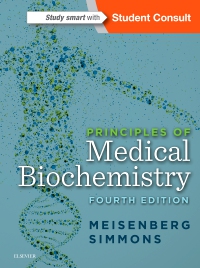
Principles of Medical Biochemistry, 4th Edition
Paperback

-
- Just the right amount of detail on biochemistry, cell biology, and genetics – in one easy-to-digest textbook.
- Full-color illustrations and tables throughout help students master challenging concepts more easily.
- Online case studies serve as a self-assessment and review tool before exams.
- Online access includes nearly 150 USMLE-style questions in addition to the questions that are in the book.
- Glossary of technical terms, both in print and online.
- Student Consult eBook version included with purchase. This enhanced eBook experience includes access -- on a variety of devices -- to the complete text, images, and references from the book.
- Evolve Instructor Resources, including a downloadable image bank and test bank, are available to instructors through their Elsevier sales rep or via request at: https://evolve.elsevier.com
-
- Clinical Boxes and Clinical Content demonstrate the integration of basic sciences and clinical applications, helping readers make connections between the two. New clinical examples have been added throughout the text.
- Student Consult eBook version included with purchase. This enhanced eBook experience includes access -- on a variety of devices -- to the complete text, images, and references from the book.
-
Part ONE
PRINCIPLES OF MOLECULAR STRUCTURE AND
FUNCTION 1
Chapter 1
INTRODUCTION TO BIOMOLECULES
Water Is the Solvent of Life
Water Contains Hydronium Ions and Hydroxyl Ions
Ionizable Groups Are Characterized by Their pK Values
The Blood pH is Tightly Regulated
Acidosis and Alkalosis Are Common in Clinical Practice
Bonds Are Formed by Reactions between Functional Groups
Isomeric Forms Are Common in Biomolecules
Properties of Biomolecules Are Determined by Their Noncovalent
Interactions
Triglycerides Consist of Fatty Acids and Glycerol
Monosaccharides Are Polyalcohols with a Keto Group or an
Aldehyde Group
Monosaccharides Form Ring Structures
Complex Carbohydrates Are Formed by Glycosidic Bonds
Polypeptides Are Formed from Amino Acids
Nucleic Acids Are Formed from Nucleotides
Most Biomolecules Are Polymers
Summary
Chapter 2
INTRODUCTION TO PROTEIN STRUCTURE
Amino Acids Are Zwitterions
Amino Acid Side Chains Form Many Noncovalent
Interactions
Peptide Bonds and Disulfide Bonds Form the Primary Structure of
Proteins
Proteins Can Fold Themselves into Many Shapes
α-Helix and β-Pleated Sheet Are the Most Common Secondary
Structures in Proteins
Globular Proteins Have a Hydrophobic Core
Proteins Lose Their Biological Activities When Their Higher-Order
Structure Is Destroyed
The Solubility of Proteins Depends on pH and Salt
Concentration
Proteins Absorb Ultraviolet Radiation
Proteins Can Be Separated by Their Charge or Their Molecular
Weight
Abnormal Protein Aggregates Can Cause Disease
Neurodegenerative Diseases Are Caused by Protein Aggregates
Protein Misfolding Can Be Contagious
Summary
Chapter 3
OXYGEN TRANSPORTERS: HEMOGLOBIN AND
MYOGLOBIN
The Heme Group Is the Oxygen-Binding Site of Hemoglobin and
Myoglobin
Myoglobin Is a Tightly Packed Globular Protein
Red Blood Cells Are Specialized for Oxygen Transport
The Hemoglobins Are Tetrameric Proteins
Oxygenated and Deoxygenated Hemoglobin Have Different
Quaternary Structures
Oxygen Binding to Hemoglobin Is Cooperative
2,3-Bisphosphoglycerate Is a Negative Allosteric Effector of
Oxygen Binding to Hemoglobin
Fetal Hemoglobin Has a Higher Oxygen-Binding Affinity than
Does Adult Hemoglobin
The Bohr Effect Facilitates Oxygen Delivery
Most Carbon Dioxide Is Transported as Bicarbonate
Summary 38
Chapter 4
ENZYMATIC REACTIONS 39
The Equilibrium Constant Describes the Equilibrium of the
Reaction
The Free Energy Change Is the Driving Force for Chemical
Reactions
The Standard Free Energy Change Determines the Equilibrium
Enzymes Are Both Powerful and Selective
The Substrate Must Bind to Its Enzyme before the Reaction Can
Proceed
Rate Constants Are Useful for Describing Reaction Rates
Enzymes Decrease the Free Energy of Activation
Many Enzymatic Reactions Can Be Described by Michaelis-Menten
Kinetics
Km and Vmax Can Be Determined Graphically
Substrate Half-Life Can Be Determined for First-Order but Not
Zero-Order Reactions
Kcat/Km Predicts the Enzyme Activity at Low Substrate
Concentration
Allosteric Enzymes Do Not Conform to Michaelis-Menten
Kinetics
Enzyme Activity Depends on Temperature and pH
Different Types of Reversible Enzyme Inhibition Can Be
Distinguished Kinetically
Enzymes Stabilize the Transition State
Chymotrypsin Forms a Transient Covalent Bond during
Catalysis
Summary
Chapter 5
COENZYMES
Enzymes Are Classified According to Their Reaction Type
Adenosine Triphosphate Has Two Energy-Rich Bonds
ATP Is the Phosphate Donor in Phosphorylation Reactions
ATP Hydrolysis Drives Endergonic Reactions
Cells Always Try to Maintain a High Energy Charge
Dehydrogenase Reactions Require Specialized Coenzymes
Coenzyme A Activates Organic Acids
S-Adenosyl Methionine Donates Methyl Groups
Many Enzymes Require a Metal Ion
Summary
Part TWO
GENETIC INFORMATION: DNA, RNA, AND
PROTEIN SYNTHESIS
Chapter 6
DNA, RNA, AND PROTEIN SYNTHESIS
All Living Organisms Use DNA as Their Genetic Databank
DNA Contains Four Bases
DNA Forms a Double Helix
DNA Can Be Denatured
DNA Is Supercoiled
DNA Replication Is Semiconservative
DNA Is Synthesized by DNA Polymerases
DNA Polymerases Have Exonuclease Activities
Unwinding Proteins Present a Single-Stranded Template to the
DNA Polymerases
One of the New DNA Strands Is Synthesized Discontinuously
RNA Plays Key Roles in Gene Expression
The Σ Subunit Recognizes Promoters
DNA Is Faithfully Copied into RNA
Some RNAs Are Chemically Modified after Transcription
The Genetic Code Defines the Structural Relationship between mRNA and Polypeptide
Transfer RNA Is the Adapter Molecule in Protein Synthesis
Amino Acids Are Activated by an Ester Bond with the 3ˈ Terminus
of the tRNA
Many Transfer RNAs Recognize More than One Codon
Ribosomes Are the Workbenches for Protein Synthesis
The Initiation Complex Brings Together Ribosome, Messenger
RNA, and Initiator tRNA
Polypeptides Grow Stepwise from the Amino Terminus to the
Carboxyl Terminus
Protein Synthesis Is Energetically Expensive
Gene Expression Is Tightly Regulated
A Repressor Protein Regulates Transcription of the lac Operon
in E. coli
Anabolic Operons Are Repressed by the End Product of the
Pathway
Glucose Regulates the Transcription of Many Catabolic
Operons
Transcriptional Regulation Depends on DNA-Binding


 as described in our
as described in our 